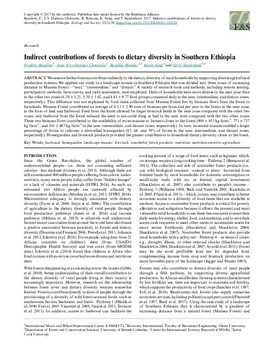Indirect contributions of forests to dietary diversity in Southern Ethiopia
We assess whether forests contribute indirectly to the dietary diversity of rural households by supporting diverse agricultural production systems. We applied our study in a landscape mosaic in Southern Ethiopia that was divided into three zones of increasing distance to Munesa Forestâ??â??near,â? â??intermediate,â? and â??distant.â? A variety of research tools and methods, including remote sensing, participatory methods, farm survey, and yield assessment, were employed. Diets of households were more diverse in the near zone than in the other two zones (6.58 ± 1.21, 5.38 ± 1.02, and 4.41 ± 0.77 food groups consumed daily in the near, intermediate, and distant zones, respectively). This difference was not explained by food items collected from Munesa Forest but by biomass flows from the forest to farmlands. Munesa Forest contributed an average of 6.13 ± 2.90 tons of biomass per farm and per year to the farms in the near zone, in the form of feed and fuelwood. Feed from the forest allowed for larger livestock herds in the near zone compared with the other two zones, and fuelwood from the forest reduced the need to use cattle dung as fuel in the near zone compared with the two other zones. These two biomass flows contributed to the availability of more manure to farmers closer to the forest (908 ± 853 kg farm-1, 771 ± 717 kg farm-1, and 261 ± 487 kg farm-1 in the near, intermediate, and distant zones, respectively). In turn, increased manure enabled a larger percentage of farms to cultivate a diversified homegarden (87, 64, and 39% of farms in the near, intermediate, and distant zones, respectively). Homegardens and livestock products provided the greater contribution to household dietary diversity closer to the forest

